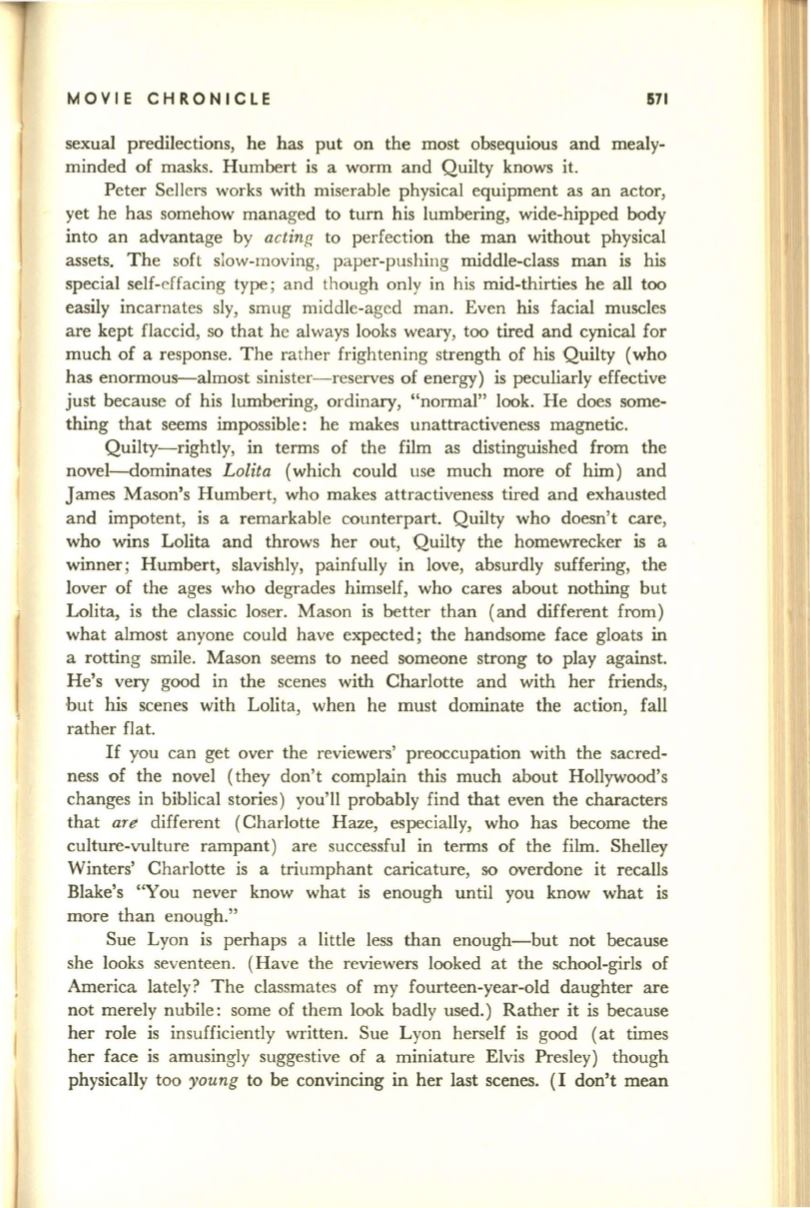
MOVIE CHRONICLE
571
sexual predilections, he has put on the most obsequious and mealy–
minded of masks. Humbert is a worm and Quilty knows it.
Peter Sellers works with miserable physical equipment as an actor,
yet he has somehow managed to turn his lumbering, wide-hipped body
into an advantage by
acting
to perfection the man without physical
assets. The soft slow-moving, paper-pushing middle-class man is his
special self-cffacing type; and though only in his mid-thirties he all too
easily incarnates sly, smug middle-aged man. Even his facial muscles
are kept flaccid, so that he always looks weary, too tired and cynical for
much of a response. The rather frightening strength of his Quilty (who
has enormous-almost sinister- reserves of energy) is peculiarly effective
just because of his lumbering, ordinary, "normal" look. He does some–
thing that seems impossible: he makes unattractiveness magnetic.
Quilty-rightly, in terms of the film as distinguished from the
novel-dominates
Lolita
(which could use much more of him) and
James Mason's Humbert, who makes attractiveness tired and exhausted
and impotent, is a remarkable counterpart. Quilty who doesn't care,
who wins Lolita and throws her out, Quilty the homewrecker is a
winner; Humbert, slavishly, painfully in love, absurdly suffering, the
lover of the ages who degrades himself, who cares about nothing but
Lolita, is the classic loser. Mason is better than (and different from)
what almost anyone could have expected; the handsome face gloats in
a rotting smile. Mason seems to need someone strong to play against.
He's very good in the scenes with Charlotte and with her friends,
but his scenes with Lolita, when he must dominate the action, fall
rather flat.
H you can get over the reviewers' preoccupation with the sacred–
ness of the novel (they don't complain this much about Hollywood's
changes in biblical stories) you'll probably find that even the characters
that
are
different (Charlotte Haze, especially, who has become the
culture-vulture rampant) are successful in terms of the film. Shelley
Winters' Charlotte is a triumphant caricature, so overdone it recalls
Blake's "You never know what is enough until you know what is
more than enough."
Sue Lyon is perhaps a little less than enough-but not because
she looks seventeen. (Have the reviewers looked at the school-girls of
America lately? The classmates of my fourteen-year-old daughter are
not merely nubile: some of them look badly used.) Rather it is because
her role is insufficiently written. Sue Lyon herself is good (at times
her face is amusingly suggestive of a miniature Elvis Presley) though
physically too
young
to be convincing in her last scenes. (1 don't mean


